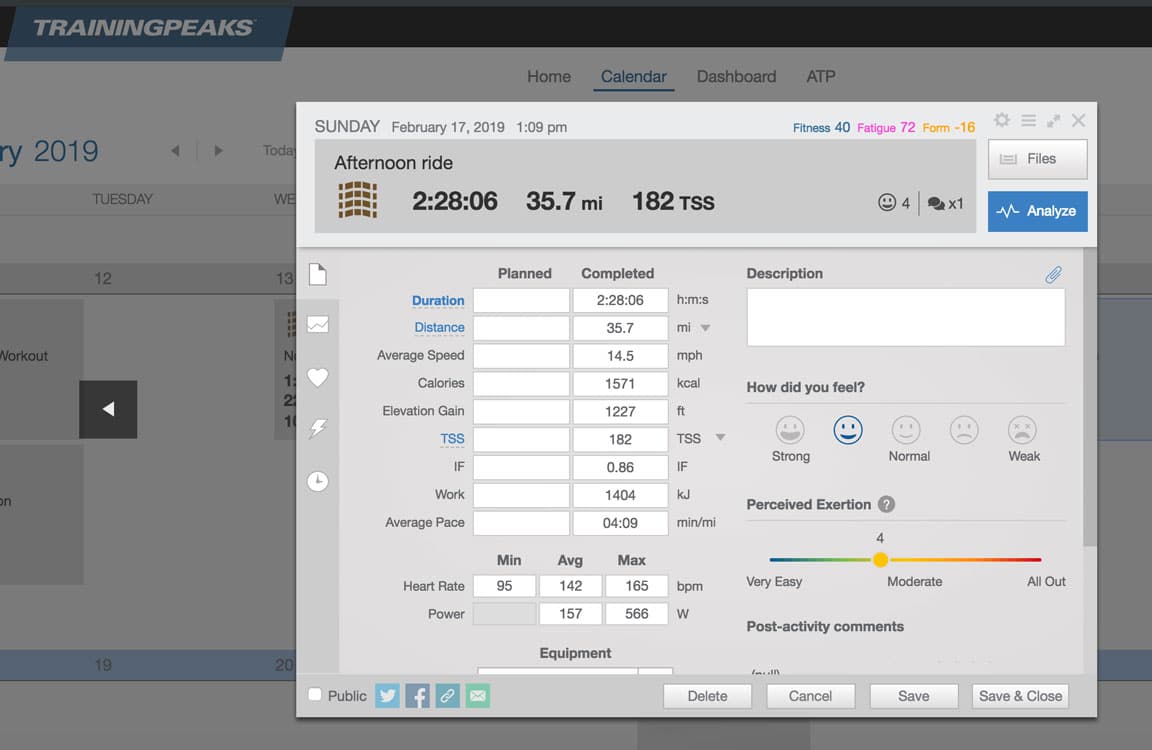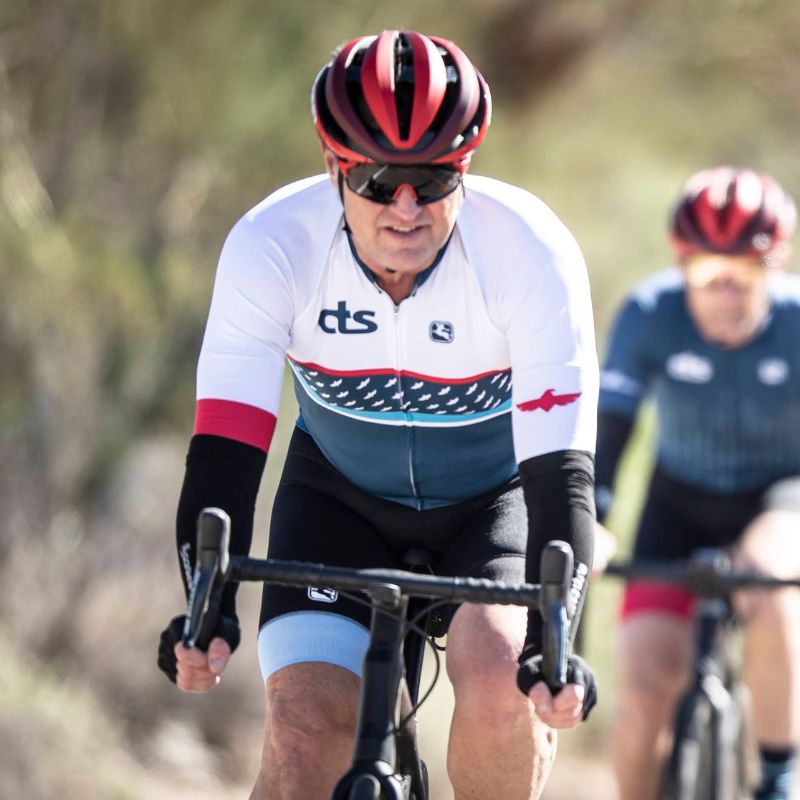
How did it go? The Importance of Tracking Subjective Feedback
By Chris Carmichael
CEO/Head Coach of CTS
Last summer, TrainingPeaks added a 5-icon rating scale athletes can use to track subjective feedback about every workout. It was a big step forward and it offered athletes and coaches a valuable new tool. After several months, at least anecdotally, the feature has been well adopted by athletes and is providing information useful for coaches. Whether you use TrainingPeaks software or not, here are some reasons you should track subjective feedback about each workout and event.
How did it go?
This is the often the first question my coaches ask athletes after a workout or race. It’s also a valuable question you should ask yourself. It’s an open-ended question that makes an athlete think and elaborate on what they felt and experienced during a workout. We can get the numerical data from a file upload. On the phone, I want to gather the context that goes along with the data.
Coaches used to say “a watt is a watt”, meaning it’s an objective data point that is directly measured. But the difficulty associated with producing 200 watts for 20 minutes is important context. When riding in 100-degree heat or on the third day of a training block, you may not be able to hold 200 watts for the full 20 minutes. Or maybe you did, but it was absolute agony and you were destroyed for the rest of the day. Or maybe you were in a great mood because you closed an important deal at work and led to a great ride where 200 watts felt a lot easier than it did two weeks ago. By incorporating a 0-10 scale of perceived exertion to the subjective data feature, athletes can provide that context very easily.
Athletes are not machines
Everything in your life affects how you perform on the bike. The stresses from your job, your decision to stop eating red meat, the fact you have been waking up twice a night to use the bathroom, a new romantic relationship… all of these things affect performance. Reciprocally, the amount, frequency, and intensity of your training affects all other areas of your life. Recording subjective feedback on a workout-by-workout basis, ideally along with keeping a journal or using the comments section in training software, helps athletes and coaches see the whole person. You are more than the sum of your power and heart rate data.
Reinforces non-physical aspects of training
Mental and emotional development is a crucial part of training, and there is no finish line for your mental or emotional development. You are always learning and adapting to new situations, and the simple act of recording a smiley icon or a frowning one provides a daily reminder to pay attention to non-physical aspects of training as often as you pay attention to your intervals and peak powers.
Simple and user-friendly
Context matters, but for a long time we relied on athletes to write comments or call us soon after workouts. Memory fades, and in the real world, many athletes only sporadically upload data, let alone write comments. By adding the 5-icon subjective feedback scale, TrainingPeaks enabled athletes to quickly enter a simple response as soon as they finish.
I like that TrainingPeaks stuck with a 5-icon scale, because keeping it simple is important. In my experience, getting more granular – either with a larger scale or by asking for subjective feedback on different aspects of a workout – reduces compliance and doesn’t add much value. It is hard for athletes to boil everything that happened in a 2-hour workout down to a single measure; adding more choices or making them report on individual variables makes the task harder.
► Free Cycling Training Assessment Quiz
Take our free 2-minute quiz to discover how effective your training is and get recommendations for how you can improve.
Identifying trends in subjective data
Over time, tracking subjective feedback may help illustrate a common scenario athletes often struggle to understand (especially as it’s happening). When performance is good, athletes are happy. You would expect lots of smiley faces during this period, with the occasional frown. When athletes are in the middle to end of a focused block of hard training, they can get grumpy and down on themselves. The workouts are hard, they’re sometimes pushing to the point of failure, and they may actually be slower than they were before. Frowny faces would be pretty common during this period.
When you reduce the training pressure after the focused block, the athlete recovers and experiences the adaptations that lead to those great days when workouts get smiley faces. In the depths of those lows, athletes struggle to see the forest for the trees. Being able to look back through subjective data from an earlier training cycle can help explain why they feel the way they do and help them gain confidence that the great days are indeed coming.
Coaches have always gathered and used subjective feedback from athletes, and I’m really glad TrainingPeaks made it easier for athletes to record it on a more consistent basis. Perhaps even more influential is that adding this simple metric to TrainingPeaks suite of data acknowledges the importance and relevance of subjective feedback to training and performance. May your future be full of smiley faces!
► FREE Mini-Course: Learn How to Maximize Your Limited Training Time
Learn step-by-step how to overcome limited training time and get faster. Walk away with a personalized plan to increase your performance.
"*" indicates required fields


Comments 4
I see an opportunity to work on a more positive attitude in the 1-5 smileys. I usually only use 2 or 3. I think my mental game could be improved by using more of the smiley range. Also, using the top end more might bring up my average outlook. That said, I’m going back and rating Thursday’s workout a 5 and today’s a 1.
I would like a “+” and “-“ option to be added to the Perceived Exertion feature. Sometimes I feel like I went a bit harder on a Recovery Run, so no longer an RPE 5, but certainly not an Endurance Run RPE 6 either. More like a 5+ or 6-.
Or the workout was supposed to be a Tempo Run RPE 8, and the motivation and energy level was not completely there. Still ran harder than a Steady State RPE 7, but certainly didn’t feel like an 8.
I guess that could be recorded as RPE 8 and a frowny face, but I would think that the coach would read that as you put out the effort (perceived exertion) of an 8, but it just didn’t feel good or was difficult.
I think it would be more revealing to record a 7+ or 8- and then the frowny face. Seems that little “+” or “-“ would immediately give the coach a lot more feedback.
Is there a report in TP to look at the trend of subjective ratings by say activity?
Good points in this article Chris. I have always been an advocate of qualitative/subjective results.